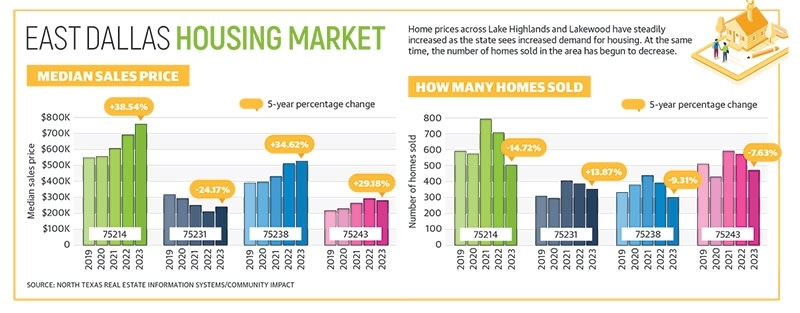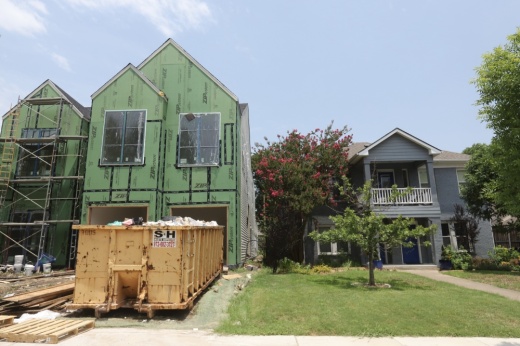As the president of the Lakewood Neighborhood Association, Boyd said the neighborhood’s character, history and sense of community are a major draw for him and many other homebuyers.
“It’s a tight-knit area, a tight-knit neighborhood,” Boyd said. “A lot of people here are long-timers, so you really get to know your neighbors and you find yourself looking out for each other.”
Now, residents in Lakewood and Lake Highlands are seeing lots of newcomers. With the North Central Texas Council of Governments predicting the region will have a population of around 10.5 million by 2040, many of those new homebuyers are looking to northeast Dallas, as Boyd did.
The northeastern part of Dallas, which includes Lake Highlands, Lakewood, Lochwood, Old East Dallas, Casa Linda, Casa View and Forest Hills, is the area homebuyers are most interested in across the country, according to a 2023 study from HouseFresh that used Zillow data to analyze home buying trends. Alongside the increased attention, home values in northeast Dallas have increased about 37% from $321,531 to $440,350 over the last five years, according to Zillow data.
Attractive neighborhoods
Julie Lynch, real estate director at The University of Texas at Dallas, said Texas is an attractive place to live due to quality of life, education options and employment opportunities. She added that the Dallas area has experienced the largest population growth among other metro areas in the country over the last decade. Just from 2021-22, the Dallas-Fort Worth area’s population grew by more than 170,000, per Census Bureau data.
A top reason homebuyers select a particular location is its proximity to employment centers, Lynch said. Lake Highlands and Lakewood are “very desirable” because of their central location in North Texas with good transportation infrastructure and good schools, she added.
To people who aren’t familiar with Lakewood’s community and history, Boyd said many are likely drawn to the area's many amenities and attractions, such as the Dallas Arboretum and Botanical Garden and White Rock Lake, which he described as “one of the crown jewels of Dallas.”
Additionally, Boyd said many people in Lakewood are attracted to the neighborhood’s unique, historic homes.
“Back in the day, a lot of thought and attention was paid to architecture and craftsmanship,” Boyd said. “That’s something that’s important to a lot of the neighbors here.”
Housing supply versus demand
Over the last several years, close to 100 major corporations, have relocated to Texas, which has increased demand for housing, Lynch said. That comes in addition to normal demand, which is generated from the existing population, as new households are created as teenagers graduate high school or young people get married.
But while the demand is increasing, many homeowners aren’t interested in selling their homes because about 40% of them have a low interest rate, and some developers are having a hard time building new ones, Lynch said.
“Their interest rates on their current mortgages are so favorable—[they’re] not going to want to sell ...So the supply of resale homes is very constrained,” Lynch said.

In Lake Highlands and Lakewood-area ZIP codes, the number of homes sold per year has decreased since 2019, as the housing market recovers from the pandemic. The only ZIP code that has seen an increase in the number of homes sold is 75231, which includes the western part of Lake Highlands and Vickery Meadow.
Lynch said pandemic-related supply chain issues prevented many houses from being built. Now, some builders are becoming more “conservative,” afraid that consumers won’t display the same level of demand, given the high interest rates.
“If you look at the available housing in North Texas right now, or actually across the country, we have a lot less inventory available now versus pre-pandemic,” Lynch said.
In the short-term future, Lynch said she believes housing prices will continue to increase due to limited supply, an increased population and high inflation costs
Affordable opportunities
As home values increase, housing advocates, city officials and developers are looking for new ways to ensure housing opportunities for residents of all income levels. Lynch said both developers and homebuyers may have to reconsider how they think of the standard ideal home.
Having grown up on the northeast coast, Lynch said she’s used to much denser housing areas than what is seen in North Texas. Considering smaller housing options could allow more homes to be built with affordability in mind in high-opportunity areas, especially as the population continues to grow.
When the topic of affordable housing is broached at City Council or community meetings, many community members often claim that low- or mixed-income housing developments could bring down their neighborhood’s property values. However, Lynch said such developments cause no long-term impact to property values.
“House values are very much determined [by] the specific home that’s for sale, what condition is the home in, what does the neighborhood have to offer.” Lynch said. “As long as all those attributes are there, the value of homes are specific to their neighborhood.”
Instead, individuals who move into affordable housing developments, typically obtain higher education and possibly more stable employment, which enables them to earn a higher income, contributing to the local economy, Lynch said. Many people also have misconceptions about who affordable housing benefits, she added. With property values as high as they are, many recent college graduates or even retirees can’t afford to buy a home and can be in need of affordable housing alternatives, which can allow them to live near their families.
Ann Lott, executive director of the Inclusive Communities Project, a nonprofit organization that works to expand fair and affordable housing opportunities for low-income families, said it’s essential to place low- and mixed-income housing in affluent neighborhoods, such as Lake Highlands and Lakewood.

Kathy Stewart, District 10 Dallas City Council member, previously said that District 10 has more low-income housing units than any other district. She referenced a 2021 memo from the Department of Housing and Neighborhood Revitalization that shows District 10 has about 36,854 affordable housing units, which is about 5,000 more than the district with the next highest count—District 12 with about 31,000. However, only 830 of District 10’s units are dedicated to residents who make 30% or less of the area’s median income, while 23,818 are for residents who make 80% of the median income.
“[Low-income families] should be able to live anywhere, but they just can’t find adequate housing in some of those higher-income areas,” Lott said. “So I just don’t know that I buy the idea that [Lake Highlands and Lakewood] have ‘enough’ housing for low-income families.”





